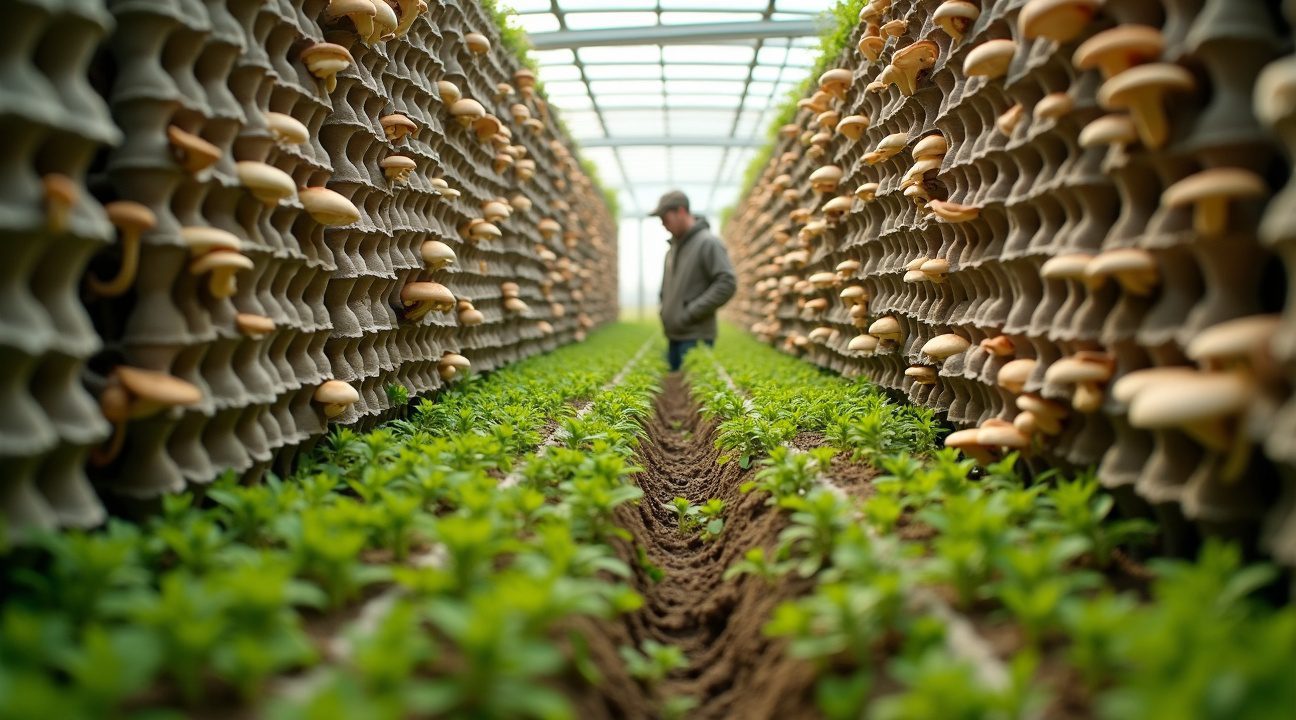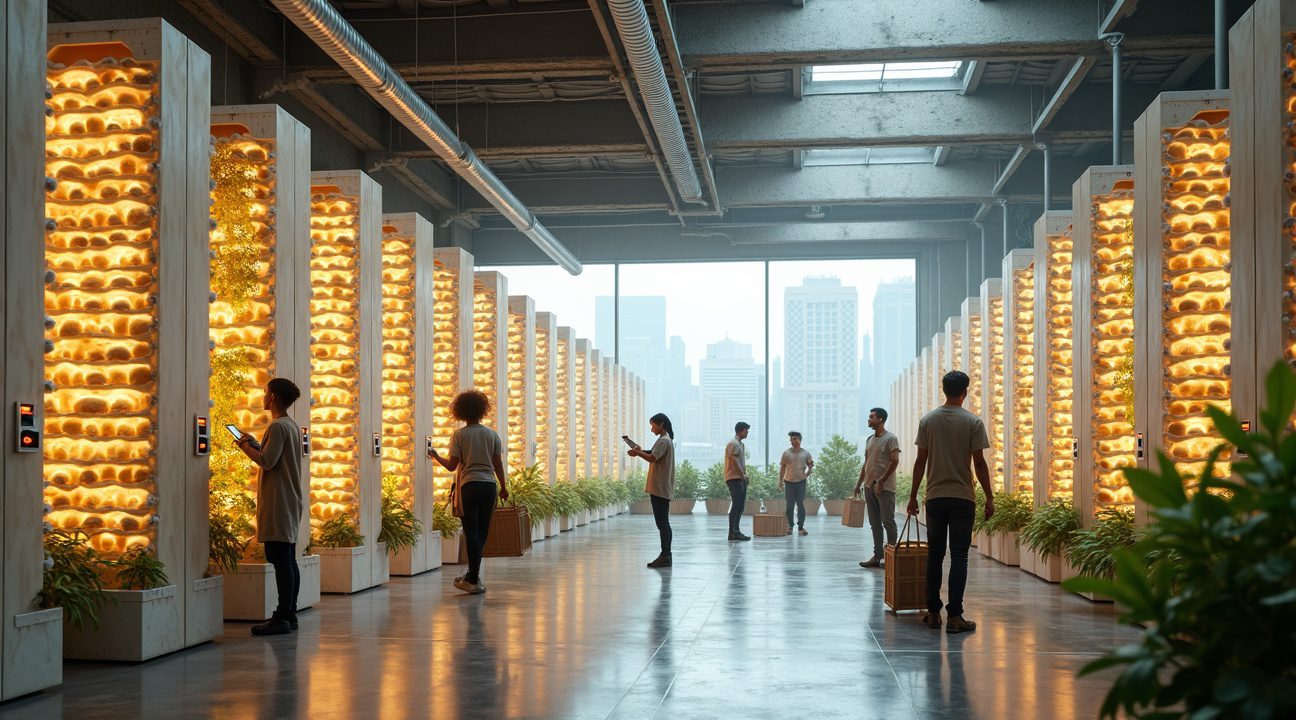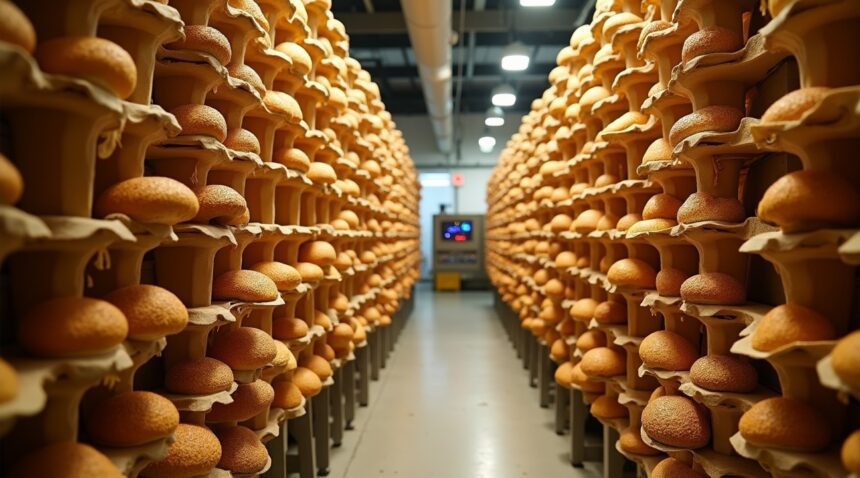Dutch agricultural innovators have pioneered a revolutionary mushroom cultivation method that employs vertical columns made from recycled egg cartons, entirely removing plastic from the growing process and optimizing sustainability and space use.
Key Takeaways
- Vertical egg carton columns allow for multiple mushroom varieties to be grown in one space, boosting yields by three to five times over traditional methods.
- The recycled cardboard material naturally regulates moisture, airflow, and humidity, reducing reliance on costly climate control equipment.
- Zero-plastic production methods lower environmental waste and production costs, fostering a circular farming model that gives new life to landfill-bound materials.
- Urban farming accessibility is greatly enhanced, enabling mushrooms to be cultivated in compact spaces like warehouses or shipping containers.
- The Netherlands sets a new benchmark for sustainable agriculture by fusing environmental responsibility with practical, scalable solutions.
Sustainable Innovation Using Recycled Materials
Farmers throughout the Netherlands are reimagining how mushrooms are produced by stacking recycled egg cartons into vertical towers that entirely do away with plastic usage. These creative systems turn trash into treasure by transforming cardboard waste into efficient agricultural infrastructure. This approach achieves a dual objective: reducing reliance on non-biodegradable plastics and increasing farming output within limited areas.
Efficient Space Utilization
The vertical tower design proves ideal for cultivating mushrooms such as oyster and shiitake in locations traditionally seen as unfit for farming. These recycled columns take advantage of cardboard’s natural absorbency and breathability to create optimal microclimates for growth. The setup eliminates the need for expensive, energy-consuming systems for regulating temperature and humidity.
By stacking columns inside urban structures like warehouses or containers, farmers increase the growing surface by up to 500%, making agriculture feasible even in cities with high real estate costs. This efficient use of space allows mushroom farming to thrive in places where horizontal bed farming is impractical.
Environmental and Economic Benefits
Every mushroom growing cycle salvages hundreds of egg cartons from the waste stream while producing nutritious food without the environmental burden of plastic packaging. After harvest, the cardboard has the added benefit of breaking down into compost, further supporting ecological agriculture.
This low-cost system is accessible and simple to implement, relying on basic tools and commonly discarded materials. The cardboard maintains its structural form throughout the growing process, effectively supporting developing mushroom clusters while regulating environmental conditions.
Natural Climate Regulation and Risk Reduction
Cardboard’s breathable quality prevents excessive moisture accumulation, a major issue in traditional plastic-based systems that often suffer from mold and contamination. This natural regulation minimizes the need for active ventilation and monitoring, reducing both energy use and hardware costs.
By providing isolated vertical growing zones, the system limits the spread of disease or contamination. Problems can be contained within single towers, preserving the rest of the crop and ensuring consistent output.
Market Viability and Adoption
A variety of markets are taking notice. Restaurants value the eco-conscious production and dependable quality. Grocers appreciate how the growing conditions extend mushroom shelf life. Direct-to-consumer marketing flourishes thanks to the system’s strong sustainability narrative that attracts environmentally aware customers.
Despite its simplicity, the vertical system matches conventional timelines for mushroom growth and delivers larger harvests in smaller footprints. Labor efficiency improves as workers access multiple production levels from a centralized location.
Scalability and Global Impact
Dutch farmers report substantial savings through reduced waste disposal, no plastic input costs, and minimal infrastructure investment. Return on investment occurs within just a few cycles, making this an economically smart and environmentally sound option.
Global agricultural organizations are now evaluating this method for widespread deployment. The system’s simplicity makes it adaptable across diverse climates and economies. Countries with limited resources can readily adopt it using local materials like egg cartons and basic tools.
To learn more about sustainable innovations in the Netherlands, you can explore resources provided by the Dutch Ministry of Agriculture for insights into ongoing agricultural transformation.
A Model for the Future
The success of the vertical egg carton model reinforces the idea that sustainability and profitability are not mutually exclusive. This Dutch-built system demonstrates that smart design, waste repurposing, and urban agriculture can converge to shape the future of global food production through accessible ecological practices.
Dutch Farmers Revolutionize Agriculture with Floor-to-Ceiling Mushroom Towers
Dutch agricultural innovators have transformed how mushrooms grow by constructing towering vertical columns from recycled egg cartons. These breathable structures stretch from floor to ceiling, creating an entirely new cultivation method that abandons traditional plastic trays and grow bags completely.
The egg carton towers maximize every inch of vertical space within growing facilities. Farmers stack the recycled cardboard containers into impressive columns that can accommodate multiple mushroom varieties simultaneously. Oyster mushrooms thrive in these structures, while shiitake and lion’s mane varieties also flourish using this unconventional approach.
Circular Farming Philosophy in Action
This innovative system perfectly embodies the Netherlands’ circular farming model, where agricultural waste becomes valuable resources for new production cycles. Rather than discarding egg cartons after their initial use, farmers repurpose them into functional growing mediums that provide ideal conditions for mushroom development. The cardboard material offers natural breathability while maintaining the moisture levels mushrooms require for optimal growth.
The zero plastic production method delivers significant cost savings for farmers while drastically reducing environmental waste. Traditional mushroom cultivation relies heavily on plastic growing bags and trays that eventually require disposal. By eliminating these materials entirely, Dutch farmers have created a system that produces food while consuming waste products that would otherwise burden landfills.
Technical Advantages of Vertical Column Systems
The vertical column design offers several practical benefits that enhance mushroom production efficiency:
- Each tower provides multiple growing surfaces without requiring additional floor space.
- The cardboard structure maintains consistent airflow, reducing moisture buildup and minimizing contamination.
- Easy monitoring and harvesting at various heights within each column.
- Modular construction allows fast adjustments and repairs without disrupting full operations.
I’ve observed how this flexibility enables farmers to optimize growing conditions for different mushroom varieties within the same vertical space.
The environmental benefits extend beyond waste reduction:
- Plastic container manufacturing uses significant energy and raw materials.
- Repurposed egg cartons eliminate that production demand entirely.
- The cardboard eventually decomposes naturally, unlike plastics that persist in landfills for decades.
This Dutch innovation demonstrates how creative thinking can solve multiple agricultural challenges simultaneously. The system addresses space limitations, reduces production costs, minimizes environmental impact, and maintains high-quality mushroom yields. Farmers adopting this method report improved efficiency while contributing to sustainable agricultural practices that other nations are beginning to study and implement.
Recycled Egg Cartons Transform from Waste to Growth Medium
The humble egg carton has found a revolutionary second life in Dutch mushroom cultivation, demonstrating how innovative thinking can turn everyday waste into agricultural gold. These simple containers, crafted from recycled paper pulp, possess characteristics that make them surprisingly perfect for mushroom growing. I’ve observed how this abundant and biodegradable material has become the backbone of vertical farming operations across the Netherlands.
Why Egg Cartons Excel as Growing Medium
Several factors make recycled egg cartons exceptional for mushroom cultivation:
- The porous structure naturally retains moisture while maintaining essential airflow, creating optimal growing conditions.
- Their textured surface provides an ideal foundation for spore attachment and early mycelium development.
- The biodegradable nature means they decompose alongside the growing cycle, enriching the growing environment.
- Their lightweight properties reduce structural stress in vertical farming systems.
- The molded compartments create perfect individual growing chambers for multiple mushroom varieties.
This innovative approach completely eliminates plastic from the production process, cutting both manufacturing costs and environmental impact significantly. Dutch growers have discovered that egg cartons serve a brilliant dual purpose—functioning simultaneously as structural support for the vertical columns and as the actual growth medium for the mushrooms. The paper pulp material breaks down gradually during the growing cycle, providing additional nutrients to the developing fungi while maintaining structural integrity.
The system represents a major step forward in agriculture’s transition to a fully circular economy. Instead of discarding millions of egg cartons annually, farms now transform this waste stream into productive agricultural infrastructure. This process reduces landfill burden while creating value from materials previously considered worthless. The economic benefits extend beyond waste reduction, as sourcing recycled egg cartons costs significantly less than purchasing traditional growing substrates or plastic containers.
Recent developments in this field remind me of other innovative ventures that challenge conventional approaches. The success of egg carton cultivation has attracted international attention, with farms in neighboring countries already implementing similar systems. This method proves that sustainable agriculture doesn’t require expensive technology or complex infrastructure—sometimes the most effective solutions come from reimagining common waste materials.

How Egg Carton Columns Create Perfect Growing Conditions
The recycled egg carton columns function as sophisticated growing environments that mushrooms naturally crave. These vertical structures maintain high humidity levels while allowing controlled airflow, creating the precise balance mushrooms need to thrive. The cardboard material acts as a moisture reservoir, slowly releasing water vapor while preventing oversaturation that could damage delicate fungal networks.
I find the breathable nature of egg cartons particularly fascinating because they regulate moisture without creating stagnant conditions. The cardboard fibers absorb excess humidity during peak periods and release it gradually when the environment becomes drier. This natural buffering system eliminates the need for expensive climate control equipment while maintaining the steady 80-90% humidity levels that most mushroom varieties require.
Limited light exposure becomes automatic within these column systems since the cardboard naturally filters harsh sunlight. Mushrooms prefer dim conditions, and the egg carton walls provide just enough light reduction while still allowing minimal illumination for proper development. This controlled lighting prevents mushrooms from developing tough, woody textures that occur under bright conditions.
Optimal Conditions for Different Mushroom Varieties
Different mushroom species respond uniquely to the egg carton environment, with each variety finding specific advantages in this growing system. The following varieties show exceptional results in vertical column setups:
- Oyster mushrooms grow rapidly along the column sides, using the cardboard surface as an anchor point for their clusters
- Shiitake mushrooms benefit from the consistent moisture levels maintained by the egg carton material
- Lion’s mane mushrooms flourish in the chemical-free environment since egg cartons contain no harmful additives or treatments
The vertical design maximizes growing surface area while the cardboard substrate provides structural support for heavier mushroom clusters. Oyster mushrooms particularly excel because they naturally grow in shelf-like formations that complement the column structure. Their fast growth rate means harvests can occur within 7-10 days of inoculation.
Shiitake varieties appreciate the steady moisture retention properties of egg cartons, which prevent the rapid dehydration that often kills these sensitive fungi. The cardboard maintains optimal water content without becoming waterlogged, a balance that traditional growing methods struggle to achieve consistently.
Lion’s mane mushrooms respond well to the stable microclimate created within the columns. These delicate fungi require protection from temperature fluctuations and contamination, both of which the egg carton system provides naturally. The cardboard acts as insulation against sudden environmental changes while its porous structure prevents harmful bacteria buildup.
Organic substrates play a crucial role in supporting mushroom nutrition within these columns. Coffee grounds provide nitrogen and trace minerals that fuel mushroom development, while sawdust offers carbon compounds essential for cellular structure. Plant waste materials contribute additional nutrients and help maintain proper pH levels throughout the growing medium.
The combination of egg carton structure and organic substrates creates a self-sustaining ecosystem where beneficial microorganisms thrive alongside the mushrooms. This symbiotic relationship enhances nutrient cycling and protects against harmful pathogens that could damage the crop. The cardboard gradually decomposes, adding cellulose to the growing medium while maintaining structural integrity throughout multiple growing cycles.
Temperature regulation happens naturally within the columns as the cardboard provides thermal mass that moderates temperature swings. This stability prevents stress on developing mushrooms while maintaining the 60-75°F range most varieties prefer. The vertical design also promotes natural convection currents that distribute heat evenly throughout the growing space.
Airflow management becomes effortless since the egg carton material allows gas exchange while preventing excessive air movement that could dry out sensitive mushroom tissues. Fresh air enters through the cardboard pores while carbon dioxide produced by the mushrooms exits naturally, maintaining the proper atmospheric composition for optimal growth.

Vertical Towers Enable Mushroom Farming in Any Urban Space
I’ve discovered that Dutch innovators have created a revolutionary approach to urban agriculture that transforms virtually any vacant space into a productive mushroom farm. These vertical mushroom towers demand remarkably little room, making them perfect for cities where every square meter counts. The beauty lies in their adaptability – entrepreneurs can establish these systems in unused warehouses, empty shipping containers, or abandoned buildings throughout densely populated areas.
Traditional farming methods simply aren’t feasible in urban environments, but these tower systems change everything. I’ve seen installations that convert former industrial spaces into thriving agricultural operations, bringing food production directly into metropolitan areas. The towers stack efficiently, maximizing growing capacity while maintaining easy access for harvesting and maintenance.
Self-Sustaining Technology Integration
Advanced hydroponic systems integrate seamlessly with these vertical structures, automatically managing moisture and nutrient levels throughout the growing process. The technology creates what I consider a near self-sustaining ecosystem, reducing manual labor while maintaining optimal growing conditions. Sensors monitor humidity, temperature, and nutrient distribution, adjusting parameters in real-time to ensure consistent mushroom production.
This automated approach eliminates much of the guesswork that plagues traditional mushroom farming. The systems maintain precise environmental controls that would be impossible to achieve manually across multiple growing levels. Farmers can monitor their entire operation remotely, receiving alerts when adjustments are needed.
Superior Yields in Compact Spaces
The efficiency gains over traditional methods are substantial. Compared to conventional flat bed systems and plastic grow bag approaches, these vertical towers achieve significantly higher yields per square foot of floor space. I’ve analyzed operations that produce three to five times more mushrooms than traditional horizontal growing methods within the same footprint.
The vertical design maximizes cubic space utilization, something traditional farming methods completely ignore. While flat bed systems waste valuable vertical space, these towers capitalize on every available inch. Each column functions as an independent growing unit, allowing farmers to:
- Harvest different mushroom varieties simultaneously
- Stagger planting schedules for continuous production
- Isolate sections for maintenance without disrupting the entire operation
- Scale production up or down based on demand
The recycled egg carton material provides excellent moisture retention and air circulation, creating ideal growing conditions while addressing waste management concerns. This sustainable approach reduces environmental impact while maintaining superior growing performance.
Urban farmers report faster harvest cycles and more predictable yields compared to traditional methods. The controlled environment eliminates many variables that affect outdoor growing, including weather fluctuations and pest infestations. This reliability allows for better planning and consistent supply to local markets.
The space efficiency means urban entrepreneurs can start mushroom operations in locations previously considered unsuitable for agriculture. Basement spaces, rooftops, and converted shipping containers all become viable growing environments. This accessibility democratizes mushroom farming, allowing more people to enter the agricultural sector without requiring large land investments.
Production costs decrease significantly when farmers eliminate transportation expenses associated with rural farming operations. Local urban production reduces the carbon footprint while providing fresher products to consumers. The proximity to markets also enables farmers to harvest mushrooms at optimal ripeness rather than picking them early for shipping durability.
These systems prove particularly valuable in food-insecure urban areas where fresh produce access remains limited. Community organizations can establish mushroom growing operations in neighborhood spaces, providing both fresh food and potential income sources for residents. The relatively simple technology makes training accessible to people without extensive agricultural backgrounds.
The modular nature of these towers allows gradual expansion as operations grow. Farmers can start with a few columns and add more as their business develops, making the initial investment manageable for small-scale entrepreneurs. This scalability removes traditional barriers to entry that prevent many people from pursuing agricultural ventures.

Netherlands Sets Global Standard for Sustainable Food Production
This innovative mushroom cultivation system represents a significant step forward in establishing a circular farming model that transforms waste into productive agricultural resources. The Netherlands has positioned itself as the global leader in sustainable agricultural innovation by developing methods that simultaneously address waste reduction, space efficiency, and food security challenges.
Revolutionary Waste Reduction Through Creative Repurposing
The Dutch approach to mushroom cultivation demonstrates how agricultural systems can dramatically reduce landfill waste by repurposing everyday materials like egg cartons. Instead of allowing these materials to contribute to mounting waste problems, farmers transform them into productive growing mediums that support high-quality food production. This method eliminates the need for traditional plastic-based growing containers, which typically end up in landfills or require energy-intensive recycling processes.
The system’s minimal space requirements make it particularly valuable in densely populated regions where agricultural land is scarce. Vertical columns maximize production efficiency while using a fraction of the space required by conventional horizontal farming methods. This spatial efficiency allows farmers to produce substantial quantities of mushrooms in urban environments, reducing transportation costs and carbon emissions associated with food distribution.
Establishing Global Benchmarks in Agricultural Innovation
This model creates a new global benchmark in sustainable agriculture by successfully combining creativity, resourcefulness, and environmental responsibility into a practical farming solution. The Netherlands has demonstrated that sustainable food production doesn’t require sacrificing quality or efficiency. Their vertical mushroom cultivation system produces high-quality food while maintaining environmental stewardship principles.
The Dutch innovation showcases how agricultural systems can operate within circular economy principles, where waste from one process becomes the input for another. This approach challenges traditional linear farming models and provides a blueprint for other nations seeking to develop sustainable food production systems. The success of this initiative could influence agricultural policies and practices worldwide, particularly in regions facing similar challenges with waste management and limited agricultural space.
By proving that recycled materials can effectively support food production without compromising quality or safety standards, the Netherlands has created a replicable model that other countries can adapt to their specific circumstances. This achievement reinforces the country’s reputation as a pioneer in agricultural innovation and sustainable farming practices.
Sources:
SonyAZ.net – “Dutch Farmers Grow Mushrooms in Vertical Towers Made from Recycled Egg Cartons”


